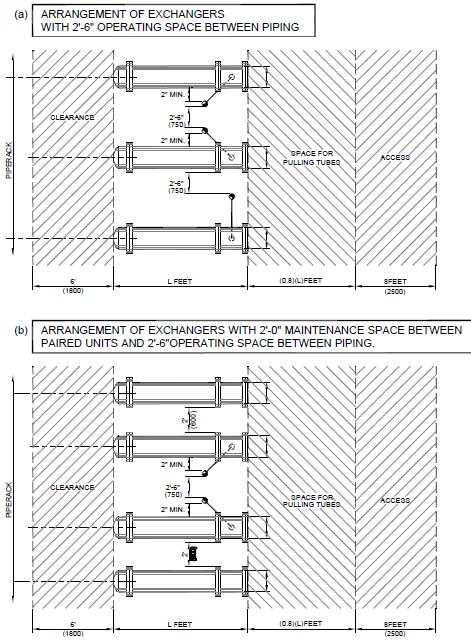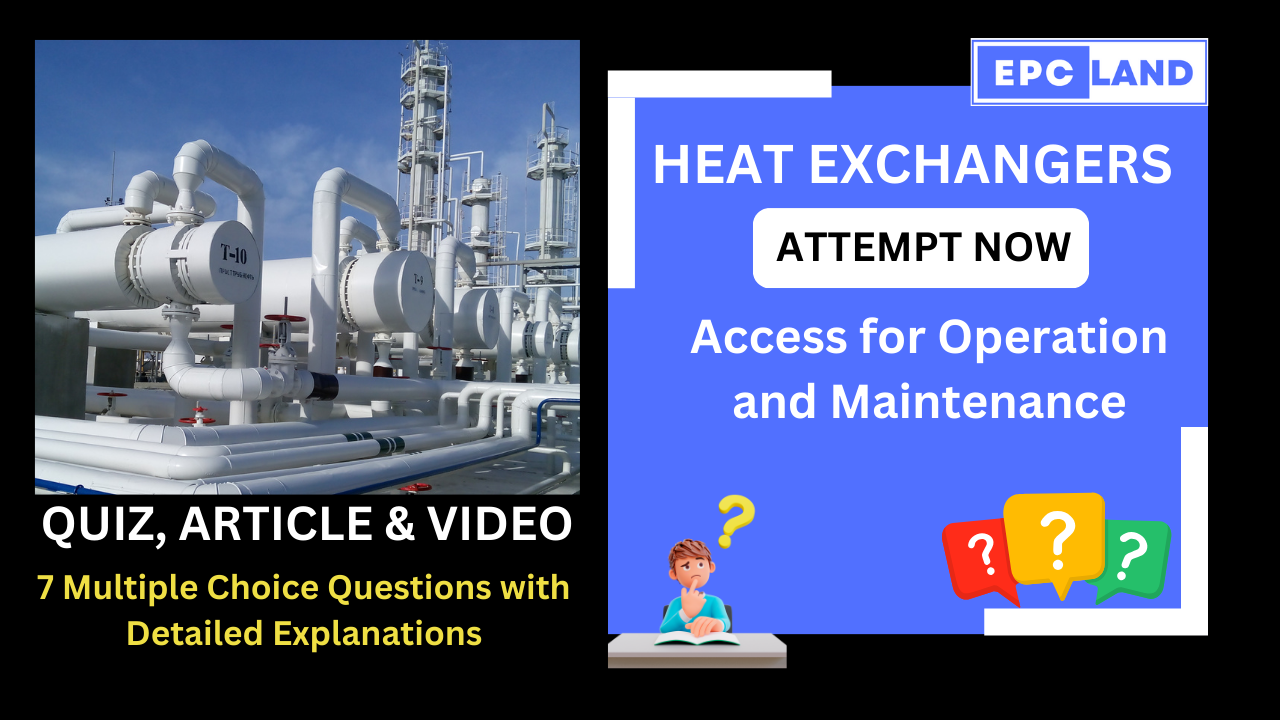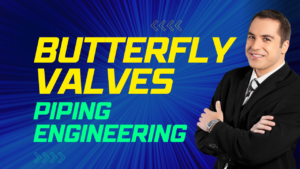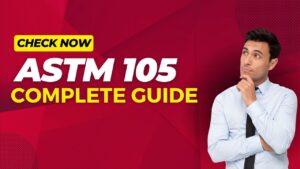1. Horizontal Clearance: Heat Exchangers Access
What is the recommended minimum horizontal clearance while planning Heat Exchangers Access between exchanger flanges or between exchanger flanges and piping?
Explanation: The recommended minimum horizontal clearance between exchanger flanges or between exchanger flanges and piping is 900mm.
2. Channel End Orientation
How should the channel ends of heat exchangers be positioned to facilitate tube bundle removal?
Explanation: The channel ends of heat exchangers should be positioned facing the local access road to facilitate tube bundle removal.
3. Access for Tube Bundle Removal
What is the recommended clearance for tube bundle removal access?
Explanation: A clearance of 500mm more than the bundle length is recommended for tube bundle removal access.
4. Mobile Equipment for Handling Tube Bundles and Covers
What is the recommended approach for handling tube bundles and covers at grade level?
Explanation: It is recommended to utilize mobile equipment for handling tube bundles and covers at grade level, minimizing the use of expensive built-in facilities.
5. Tube-Bundle Extractor
What is the function of a tube-bundle extractor in the context of maintenance?
Explanation: A tube-bundle extractor is employed to eliminate the need for permanent tube bundle removal structures, providing a more compact and efficient solution.
6. Platform Arrangements for Air-Cooled Exchangers
What considerations should be taken into account when designing platform arrangements for air-cooled exchangers?
Explanation: Platform arrangements for air-cooled exchangers should be designed to accommodate maintenance access requirements, including considerations for fin-tube bundle removal, tube rodding out at header boxes, and motor and fan access.
7. Easily Removable Spool Pieces, Flanged Elbows, Break Flanges, and Short Pipe Runs
Why is it recommended to incorporate easily removable spool pieces, flanged elbows, break flanges, or short pipe runs in the design?
Explanation: Incorporating easily removable spool pieces, flanged elbows, break flanges, or short pipe runs is recommended to facilitate exchanger maintenance by simplifying access and reducing complexity.
Short Article on Heat Exchangers Access for Operation and Maintenance
Access for Operation and Maintenance
Horizontal Clearance
- Maintain a minimum horizontal clearance of 900mm between exchanger flanges or between exchanger flanges and piping.
- In limited-space scenarios, the clearance between alternate exchangers may be reduced.
- Ensure that the clearance over insulation between channel flanges is never less than 600mm.
Channel End Orientation
- Position the channel ends of heat exchangers facing the local access road to facilitate tube bundle removal.
- Orient the shell cover towards the piperack.
- Prevent pulled-out bundles from extending over the main access road.

Access for Tube Bundle Removal
- Provide a clearance of 500mm more than the bundle length for tube bundle removal access.
Mobile Equipment for Handling Tube Bundles and Covers
- Utilize mobile equipment for handling tube bundles and covers at grade level.
- Minimize the use of expensive built-in facilities such as lifting beams and monorails.
Tube-Bundle Extractor
- Employ a tube-bundle extractor to eliminate the need for permanent tube bundle removal structures.
- These compact mechanisms weigh around seven tons and can generate pull forces of approximately 500,000lbs.
- The tube-bundle is held in position by a crane and balanced by the extractor’s leveling cradle.
- Hydraulic force is used to pull the tube-bundle out of its shell using pull rod attachments.
Platform Arrangements for Air-Cooled Exchangers
- Design platform arrangements for air-cooled exchangers to accommodate maintenance access requirements.
- Consider fin-tube bundle removal, tube rodding out at header boxes, and motor and fan access.
Easily Removable Spool Pieces, Flanged Elbows, Break Flanges, and Short Pipe Runs
- Incorporate easily removable spool pieces, flanged elbows, break flanges, or short pipe runs to facilitate exchanger maintenance.
Table of Contents
Don’t miss the Course on Effective Isometrics Management: Check Now
Enrollment Link
Recommended courses (Published on EPCLand)
- Complete Course on Piping Engineering
- Basics of Piping Engineering
- Piping Layout Engineering
- Piping Material Engineering
- Piping Stress Analysis
- Material Requisitions
- Piping Material Specifications
- Valve Material Specifications
- Plant Design & Layouts-OISD 118
- Isometric Management
Library of Technical Articles
Don’t miss out the collection of 15+ articles on following topics:
- Basics of Oil and Gas Industry
- Valves
- Testing
- Tank
- Piping Bulk Items
- Pipe
- Metallurgy
- Piping Materials
- Layout
- Instrumentation
- Heat Exchanger
- Type of Contracts
- Codes and Standards
- ASTM Standards
- Articles on Piping Specialty Items
Video details of Complete Course on Piping Engineering
Why Enroll in the EPCLand
Proven Track Record– PTR
Activities & Achievements before launching EPCLand
- Published more than 50+ short courses
- 3000+ Enrolments
- More than 3,500,00 Minutes of watch hours in the last 2 years
- 4000+ Students in 100+ Countries
- Rating of 4+ out of 5
- 1000+ YouTube Videos
- 8K+ Subscribers
What Students will Learn
- Codes & Standards of the Energy Sector
- Piping Material Engineering
- Piping Layout Engineering
- Stress Analysis
Interesting facts
- All the published courses have been developed by Industry Experts with more than 2 decades of experience
- Content is based on Practical experience and real-time problems.
- Content is designed and organized in such a manner that it can be easily grabbed.
- Complete website, Blogs and Quiz sections are Planned, Designed and published by myself (About me: Atul Singla)
- Complete flexibility of Time & Location, Students can access the content from anywhere & anytime
- Moreover, once enrolled, the content can be access as many times as you want, which helps in understand the fundamentals in a better way.
Conclusion
In conclusion, our courses are meticulously crafted by industry experts with over two decades of hands-on experience. The content is rooted in practical knowledge, addressing real-time problems. The material is thoughtfully designed and organized for easy comprehension. Every aspect, from the website to blogs and quizzes, has been planned, designed, and executed by Atul Singla, ensuring a comprehensive and seamless learning experience. With the flexibility of accessing the content at any time and from any location, students have the freedom to learn on their terms. Furthermore, enrollment grants unlimited access, allowing learners to revisit the material as often as needed, fostering a deep understanding of the fundamentals.



